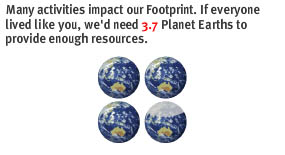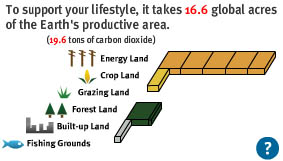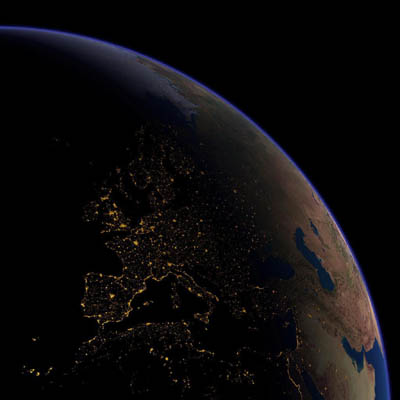Like Thomas Jefferson, I eat a plant-based diet, with occasional meat in small portions. Like most Americans, I have no idea where the food I consume comes from, or how far it had to travel before reaching my dinner plate.
My pickup truck, which gets about 20 MPG. Occasionally On rare occasions, I ride my bicycle to work, but I usually don’t have the time or inclination.
I live alone in a free-standing house. It’s well insulated with energy-efficient windows, but, at around 900 square feet, it’s much more space than I need. Every square foot of space I don’t use eats up electricity in heating and air conditioning.
If every one of the 6.5 Billion people on the planet lived like me, we would need 3.7 Earths to support them all.
 3.7 Earth’s to Support a Planet of Ryan Sommas |
It takes 16.6 acres of biologically productive land to support my lifestyle. There exists 4.5 acres for each person on our planet.
 16.6 Global Acres to Support One Ryan Somma |
The average American requires 24 acres, nearly six times our allotment. It takes an immense quantity of resources to support the electricity, running water, roads, infrastructure, and myriad conveniences that go into our first-world lifestyles. There are only 300 million of us living at this 24 acre standard of living, but that’s about to change.
 Breakdown of Ryan Somma’s Ecological Footprint |
China and India, with their combined 2.5 billion people, are quickly coming into America’s first world standard of living. These countries are now bringing one new coal-fired power plant online every week, further stressing our limited coal and oil resources and contributing to carbon dioxide levels in our atmosphere that are already past environmental sustainability.
Aristotle observed, “That which is common to the greatest number has the least care bestowed upon it,” and we see this fact played out all over the world today. Once the fourth largest lake in the world, the Aral Sea has shrunk to under half its size in the last 50 years since the Soviets diverted the rivers feeding it for irrigation purposes. The Colorado River now often dries up before it reaches Baja, California due to overuse upstream.
We see this same over-consumption of our shared resources repeated in vanishing biodiversity, overfishing, air, water, and soil pollution, traffic congestion, noise pollution, light pollution, radio frequencies, and excessive advertising. This natural tendency of most lifeforms, not just humans, to exploit resources until they collapse, vanish, or are ruined is referred to as the Tragedy of the Commons.
 Earth Lights (Click for Larger version) Credit: NASA |
The humanist visionary Buckminster Fuller popularized the term “Spaceship Earth” as a means of characterizing our relationship to our planet: inescapable and the only one we have. If its life support systems fail us, then we fail. Our situation is that simple, but understanding how our actions affect our environment is a process of perpetual learning.
You can find out your ecological footprint at ecofoot.org.
Comments
4 responses to “This Spaceship Earth”